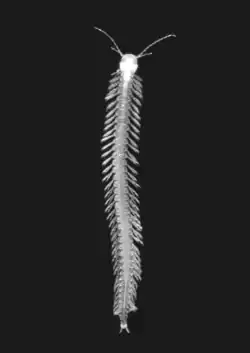Speleonectidae
| Speleonectidae | |
|---|---|

| |
| Speleonectes tanumekes | |
| Scientific classification | |
| Kingdom: | Animalia |
| Phylum: | Arthropoda |
| Class: | Remipedia |
| Order: | Nectiopoda |
| Family: | |
Speleonectidae is a family of remipedes in the order Nectiopoda. There are at least two genera and about seven described species in Speleonectidae.[1][2]
Genera
These two genera and seven species belong to the family Speleonectidae:[3][4][5]
- Lasionectes Yager & Schram, 1986
- Lasionectes entrichoma Yager & Schram, 1986
- Speleonectes Yager, 1981
- Speleonectes epilimnius Yager & Carpenter, 1999
- Speleonectes gironensis Yager, 1994
- Speleonectes kakuki Daenekas, Iliffe, Yager & Koenemann, 2009
- Speleonectes lucayensis Yager, 1981
- Speleonectes minnsi Koenemann, Iliffe & van der Ham, 2003
- Speleonectes tanumekes Koenemann, Iliffe & van der Ham, 2003
Several former Speleonectes species have recently been transferred to other genera:[5]
- Speleonectes atlantida (to Morlockia atlantida)
- Speleonectes benjamini (to Angirasu benjamini)
- Speleonectes tulumensis (to Xibalbanus tulumensis)
References
- ^ "Speleonectidae Report". Integrated Taxonomic Information System. Retrieved 2020-01-25.
- ^ "Speleonectidae". GBIF. Retrieved 2020-01-25.
- ^ WoRMS. "Speleonectidae Yager, 1981". World Register of Marine Species. Retrieved 6 February 2020.
- ^ WoRMS. "Lasionectes Yager & Schram, 1986". World Register of Marine Species. Retrieved 6 February 2020.
- ^ a b WoRMS. "Speleonectes Yager, 1981". World Register of Marine Species. Retrieved 6 February 2020.
Further reading
- von Reumont, Bjoern M.; Jenner, Ronald A.; Wills, Matthew A.; Dell'Ampio, Emiliano; et al. (2011). "Pancrustacean phylogeny in the light of new phylogenomic data: support for Remipedia as the possible sister group of Hexapoda". Molecular Biology and Evolution. 29 (3): 1031–1045. doi:10.1093/molbev/msr270. PMID 22049065.
- Yager, Jill (1981). "Remipedia, a new class of Crustacea from a marine cave in the Bahamas". Journal of Crustacean Biology. 1 (3): 328–333. doi:10.2307/1547965. JSTOR 1547965.